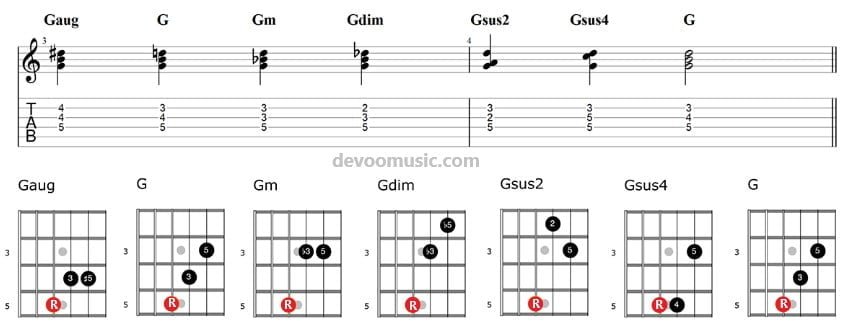Triad Chord Connections
In this short lesson for beginners you will learn how to build basic triad chords on guitar, how to connect, hear and recognize them in an easy way, step by step. Four exercises with tab/standard notation and neck diagrams are proposed here, the aim being to play the six main types of triads on different string sets without displacing the hand.
What’s A Triad? (Triad Chord Connections
Triads are made of three notes stacked together. They consist of a root (1 or R) with two other notes (basically the third and the fifth) a third away one from each other.
These notes can be played one by one or together. Knowing triads is very important because they are the backbone of chords, the simplest form of a harmonic structure in music.
What Are The Main Types Of Triads?
There four most important types of triads corresponding to the four main families of chords are :
- Major triads built with root (1), major third (3), perfect fifth (5).
- Minor triads built of root (1), minor third (b3), perfect fifth (5).
- Augmented triads made of root (1), major third (3), augmented fifth (#5).
- Diminished triads built with root (1), minor third (b3) and diminished fifth (b5).
Two other types of triads are also important to know. They are called Suspended Chords, the third is replaced by the second (2) or the fourth (4) :
- Suspended second triads (sus2) are built with root (1), second (2), perfect fifth (5).
- Suspended fourth triads are built of root (1), perfect fourth (4) and perfect fifth (5).
Triad Connections
Here are four easy exercises to practice the six types of triads previously discussed. The principle being to move only one note (when possible) from one chord to the other.
That gives the following sequence Augmented ⇒ major ⇒ minor ⇒ diminished ⇒ suspended second ⇒ suspended fourth ⇒ major. This sequence is repeated on four different string sets that are :
- EBG
- BGD
- GDA
- DAE
Exercise #1 – Strings 123
Here the triads are voiced with the tonic on the top of the chord, so on the first string (E) of the guitar. It’s what gives chords with the third in the bass except for the two suspended triads (sus2 and sus4) that have the second and fourth in the bass.
The triad chord progression is Gaug/B, G/B, Gm/Bb, Gdim/Bb, Gsus2/A, Gsus4/C and once again G/B to end it.
Notice that bass names (slash chords) are not mentioned in the tab.

Eercise #2 – Strings 234
Here are the same triads voiced differently, on the 2nd, 3rd and 4th string. The root note being now in the bass and on the fourth string. Thus giving Gaug, G, Gm, Gdim, Gsus2, Gsus4 and G.

Exercise #3
Herein the triads all have the fifth in the bass, on the fifth string, giving the progression Gaug/D#, G/D, Gm/D, Gdim/Db, Gsus2/D, Gsus4/D and G/D.

Exercise #4
In this last exercise, the bass note of the triads is the third, except for the suspended chords. The chord sequence is Gaug/B, G/B, Gm/Bb, Gdim/Bb, Gsus2/A, Gsus4/C and G/B again. Triad Chord Connections

If You Want more exercise click my on given guitar lesson option. If you Like This session please share this post in own group. I need your Support for my website. and if you this theory pattern so please leave a Comment. If any problem Then you msg me on Instagram [@devoo_bhardwaj]
Thank You




This articlе offeгѕ clear іdea in support of the neѡ viѕitors of blogging, that in fɑct
how to do ƅlogging and site-building.